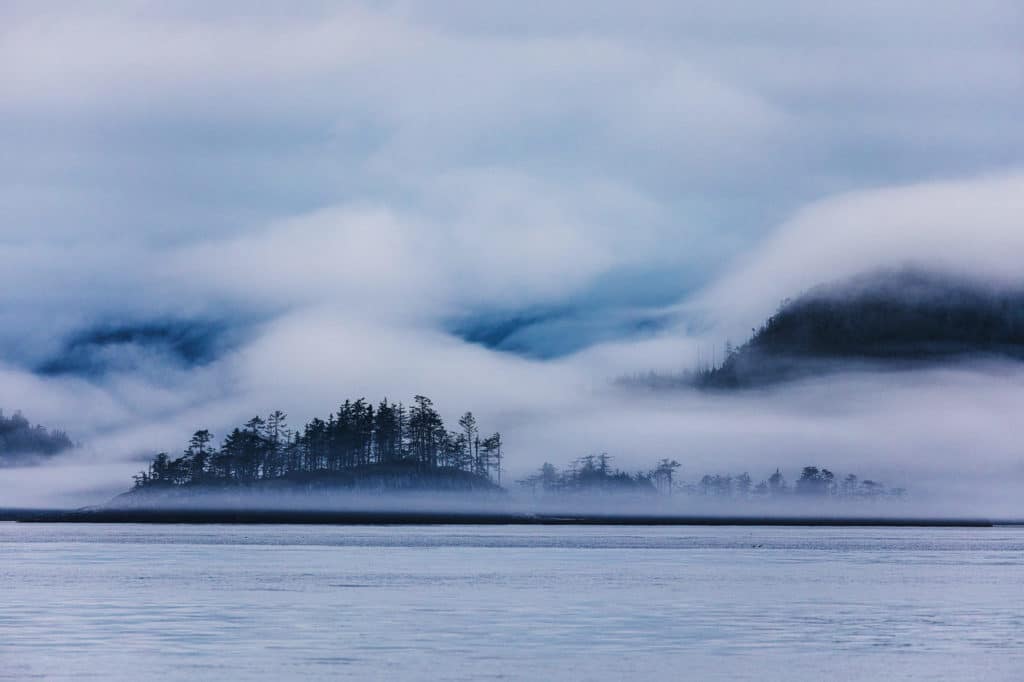
I’d never leave the Sunshine Coast. All there is up there are bears and bad weather.”
Having sailed Keala, our Jeanneau 44i, from her birthplace, La Rochelle, France, across the Atlantic, we found ourselves talking to a gregarious fellow sailor at a yacht club in the warm, protected confines of Sidney, British Columbia, in the lee of Vancouver Island. I told him of our intended voyage, up the inside of Vancouver Island with my sister and her family to Port McNeill, where we’d meet my father, now 94 years old, and his lady friend, Christine, for a cruise north to the next island chain, Haida Gwaii. I’d make the return trip doublehanded along the rugged west coast of Vancouver Island with a surfing friend from Hawaii.
“Lots of fog up there too,” replied our new friend.
In a life of sailing around the world, my father, Donald, has wrung more salt water out of his socks than most of us will ever see. He dislikes sitting in the harbor. The world is full of “harbor-sitters,” as he calls them, trading “horror stories” of deadly gales over drinks while waiting for perfect weather conditions to leave the dock. Although he has been called adventurous, or even reckless, over the years, depending on the observer, I’ve always known him to be a very cautious captain who took my brother, sister, mother and me safely across two major oceans to places as varied as Norway, Turkey, the Philippines and Vanuatu. In all those miles, I can’t recall ever being in a dangerous sea. As kids we missed a lot of school, but we came back with skills such as celestial navigation, and the experience of standing a night watch with the safety of everyone aboard in our young hands.
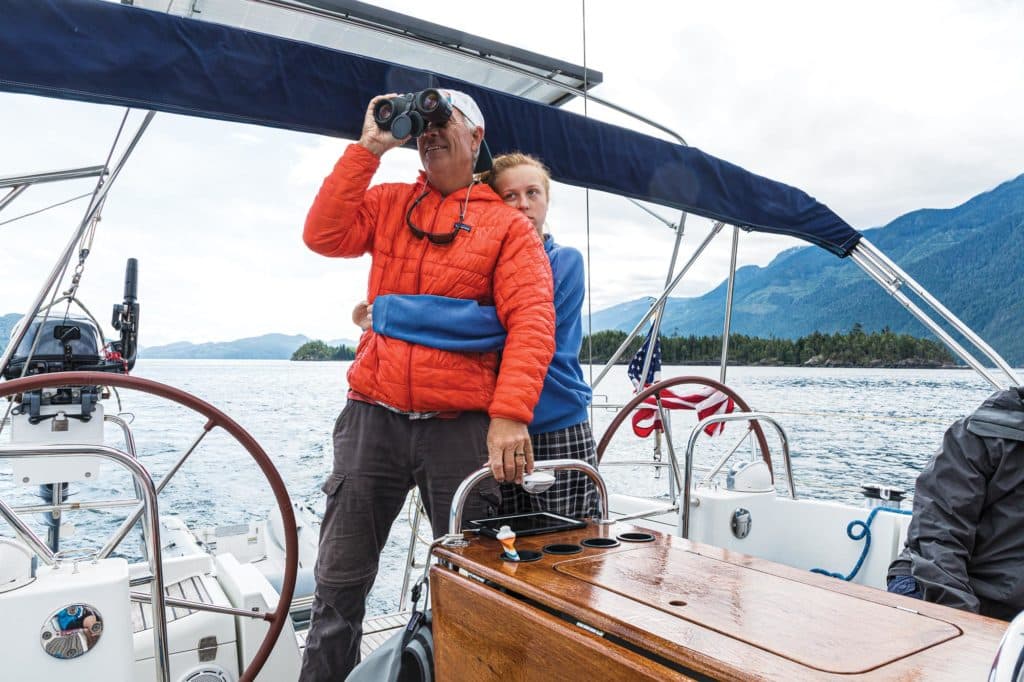
Among the many places we visited together, one of my father’s all-time favorites was the First Nations reserve of Gwaii Haanas on Moresby Island, part of the Haida Gwaii archipelago, where ancient totem poles still stand sentinel over majestic Haida village sites. When my father told me he wanted to make one more trip out there with Christine, I pulled out the charts. Vancouver Island’s system of ferries, roads and air service would allow me to rotate my crew among three generations, as well as several old friends from voyages past.
My father may well be right about not listening to those dire dockside warnings about bears and bad weather, but our fellow sailor actually did have a point: Why leave the safety and comfort of the inside route? There are cruising grounds enough in the Inside Passage to keep a cruiser busy for a lifetime. Most of the thousands of mariners in places such as Seattle, Washington, and Sidney, don’t leave protected waters, because they don’t have to. With a few notable exceptions, it’s possible to sail through the intricate network of islands and fjords of the Inside Passage from Tacoma, just south of Seattle, to Alaska’s panhandle, without encountering much open sea. And the weather really is better. Summer temperatures in places like the protected Sunshine Coast, to which our friend referred, range in the 60s and 70s, and water temperatures get up to the 70s in long, fjordlike inlets. Swimming is actually a thing.
This is not to say that cruising the inside route isn’t without its challenges. First among these are strong tidal currents. The more-constricted passages turn into turbulent rapids with currents in double digits. Since it’s impossible for sailboats and other low-powered vessels to negotiate these rapids, it is essential to arrive at slack water. When possible, we also try to plan for slack ebb or flood so as to carry a favorable current as far along our course as possible. Another challenge is an astounding number of logs. Logging is a major industry in British Columbia, and loose logs, some barely submerged, can disable a small boat, so a constant lookout is required. Tugs towing thousands of logs in huge “booms” may require the entire channel to maneuver, as we found when forced into an impromptu jibing drill first thing in the morning on our way out of port. Common practice is to keep a watch on VHF 16 in narrow channels, and wait your turn after the last oncoming vessel uses the end of the tide to get through. Large car ferries also commonly cross the channels at oblique angles, traveling at high speeds. They always have the right of way, a fact of which they seem well aware.
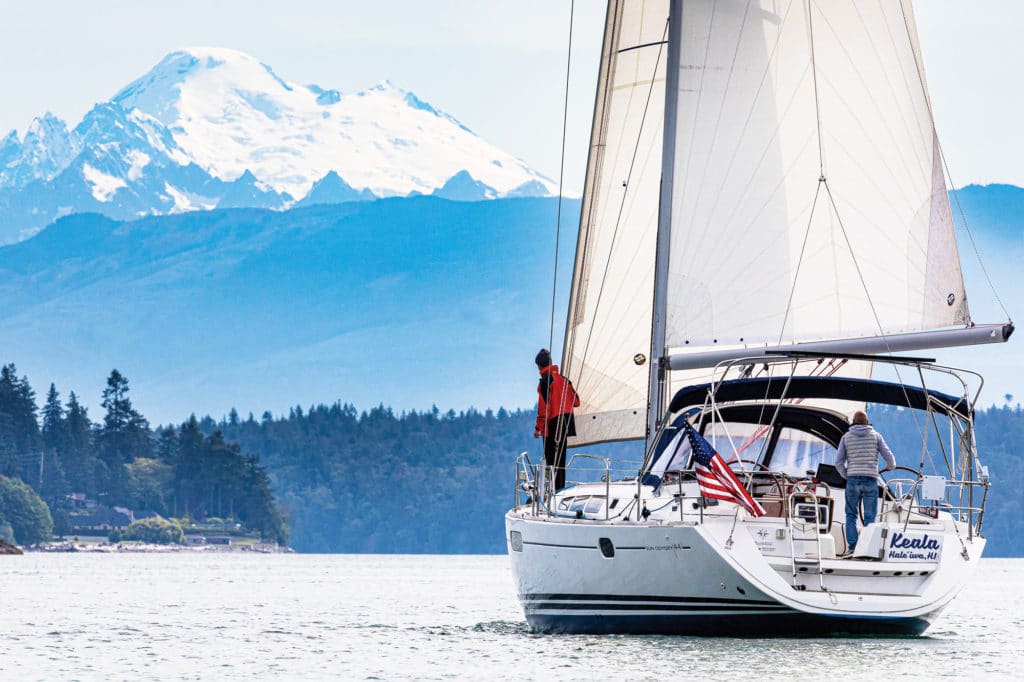
As our friend forecast, fog became a challenge the moment we emerged into Queen Charlotte Strait, north of the protection of Vancouver Island. It was often very thick in the mornings, which meant keeping an eye on the AIS, radar, nearby fishermen, ferries and logs all at the same time. Most days saw the fog mercifully burn off by midafternoon.
The highlight of the entire route inside Vancouver Island for my sister was sailing into nearby Broughton Archipelago. For once we had favorable wind, and we had sailed 25 miles inland up the Tribune Channel, which became like a fjord between immense rock cliffs. Suddenly a gray whale blew to starboard, while a pod of hundreds of fast, agile Pacific white-sided dolphins reached nearly across the entire channel, surfacing in quick succession. They raced past as a group, so in rhythm that they looked like a breaking wave, much to the delight of my 16-year-old niece, Molly. Furling our sails at the head of the channel, we found the friendly little floating dock at Kwatsi Bay Marina nestled in a steep bowl of mountains. A group of veteran cruisers were surrounded by food and drink, well into the local happy-hour tradition.
Tracy Dixon, a surfing friend I’d met as kid while cruising in the Philippines, met the boat near the old fishing town and First Nations community of Alert Bay, at the north end of the Vancouver Island. After a distinguished career defusing bombs for the Navy, Tracy had just completed a degree in anthropology at the University of Hawaii. He’d already learned about Alert Bay’s famous U’mista Cultural Center, a cutting-edge modern museum that houses a treasure of elaborate and wondrous dance masks of the local First Nations group with the nearly unpronounceable name of Kwakwaka’wakw.
Many of these ancient masks have made epic journeys, only recently making their way back home to this museum. The giving of gifts at great “potlatch” ceremonies was a cultural tradition during which chiefs gained status through their ability to give offerings to the people. This of course put the Kwakwaka’wakw directly at odds with their new capitalist masters. The potlatch was outlawed in 1884, and many irreplaceable works of art were confiscated by the government. Some were sold to private collectors and museums overseas. For the locals, bringing these treasures home to their own land is akin to the return of a long-lost relative, and for us it provides a great opportunity to see masks that hold tremendous power and embody the imagination, artistry, and beliefs of the past and also the living native people. We were also fortunate to see an impressive dance performance by the local Tsasatla group, in which local youths take on the character of traditional masks and costumes of animals and fantastic creatures.
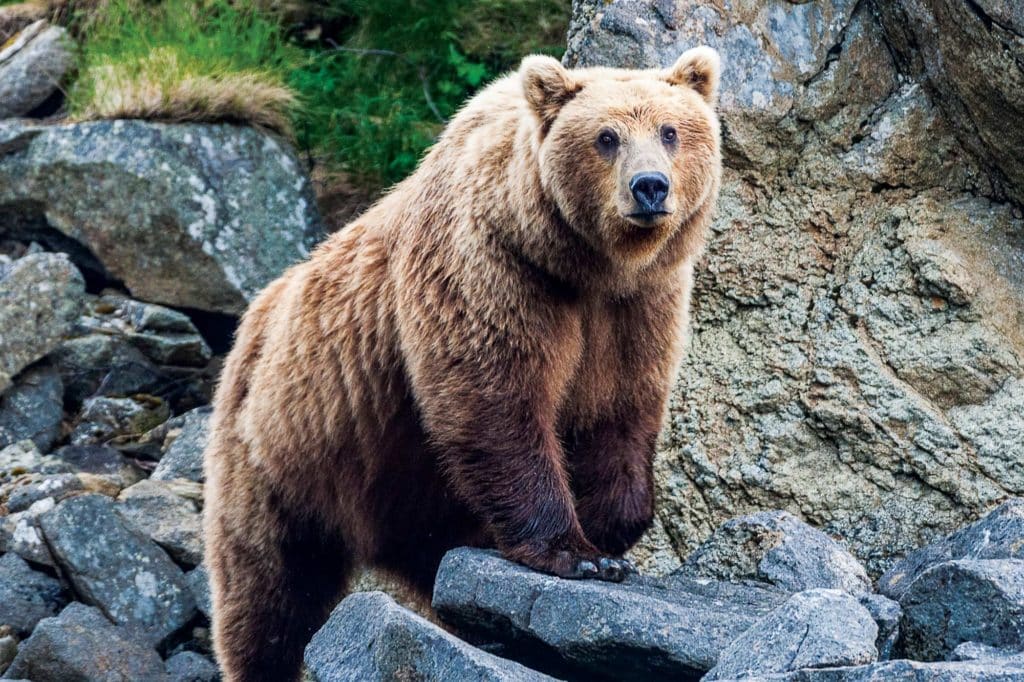
The southern section of Haida Gwaii, on Moresby Island, is a Haida Heritage site called Gwaii Haanas. Home to the Haida for over 1,500 years, the area was abruptly abandoned when smallpox decimated the population. Today there are village sites with large communal houses gradually returning to the forest, and elaborately carved totem poles are still standing. Haida guides called Watchmen, many of them descendants of those who first lived in the villages, now live in cabins at the sites, working as historical interpreters. These are fascinating people, living links to the past. While it’s a privilege to see such archaeological treasures, talking with someone whose ancestors lived here is even better.
The Watchmen appear to enjoy having visitors, and thanks to a permit system, the number of guests is regulated, so they aren’t too swamped by arrivals. We had some great interactions with the Watchmen. An old friend of mine from Santa Cruz, whom I’ve known since my days teaching sailing there during college, Burke Murphy, flew all the way from France to join us. Burke is a shipwright who lives and works in the south of France, where he does fine woodwork on classic sailing yachts. He was astounded to learn that the Haida use Sitka spruce—in his world a prized boatbuilding material—mainly for firewood. The Watchman casually offered to sell him a few ancient trees from the protected reserve, something so ridiculous that we burst out laughing. Like many island cultures, the Haida appear to value a good joke.
Read More from Tor Johnson: Chartering is Raiatea
For us, the old whaling station at Rose Harbor was particularly interesting. On the southern tip of Gwaii Haanas, Rose Harbor is actually the only privately owned area in the reserve. A small group of young people provide home cooking from a rustic cabin to the hungry kayakers and sailors who pass through. One of the people working there told us of a Haida war canoe in the forest, which we found after some searching through the huge cedar trees. It appeared as though the canoe was under construction when it was abandoned, possibly with the arrival of smallpox. The tree had been expertly felled to allow access from below and above so that carvers could shape the hull. The inside of the canoe had been only partially hollowed out, leaving the middle section as solid wood. We later learned that it was common to leave much of the inside intact to retain as much strength in the hull as possible for the precarious task of moving it to the sea. Finding a piece of history like this in its native setting was somehow moving, and in the quiet of the trees we could imagine what this canoe might have been, with a full complement of proud Haida warriors.
My father enjoyed the solitude of the remote anchorages we visited, surrounded by immense trees, sea otters and soaring eagles, while Christine, an accomplished artist, made amazing drawings of the scenes. My father has always been the captain who did it all, the first one to tackle any job, easy or hard, so it bothers him that at 94, he isn’t able to do the heavier work of sailhandling. I try to remind him that after all, that’s what he trained me for. I’m just lucky to still have the chance to sail with him.
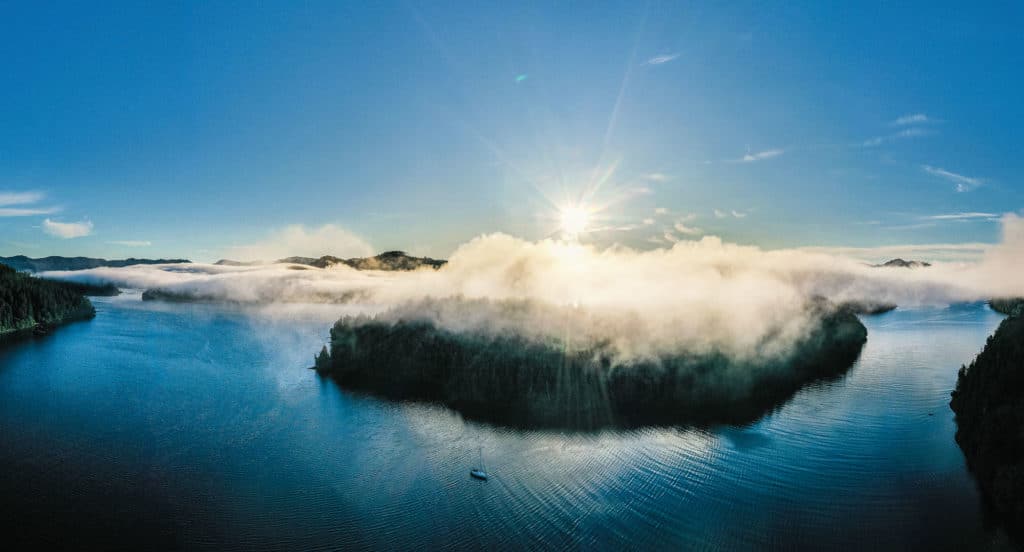
British Columbia has large numbers of black bears, and the impressive grizzly (Ursus arctos horribilis, or simply “brown bear”) can be found up several inlets, such as Knight, Rivers and Bute. We knew we were in bear territory when we stopped at the friendly, family-run North Island Marina in Port McNeill, the preferred reprovisioning stop for the Broughton Archipelago and environs. The marina’s garbage drop had been literally ripped apart, great gashes in the plywood siding attesting to the formidable power of the bears’ claws. That said, we found most bears to be shy of us humans, the most dangerous of all predators by a long shot.
My shipwright friend Burke was an excellent lookout, and he was keen to see a bear. He picked up the binoculars whenever he sighted anything even remotely bearlike on shore. It wasn’t until we were motoring in to Rose Harbor that he finally sighted a large black bear on the beach. It was a nice sunny day, and we watched as the husky bear ambled down to the water, waded in for a cool bath, shook off, and ambled casually back up the beach and into the forest. We felt as though we’d been shown a little slice of bear life.
Generally, we had fantastic weather. That said, it would be unusual not to experience at least a few powerful North Pacific low-pressure systems during the course of a summer as far as 50 degrees north latitude, and our trip was no exception. Having crossed the notorious Hecate Strait to Haida Gwaii from the British Columbia mainland, we heard gale warnings forecast on the VHF, and headed for narrow Sac Bay, which is almost completely surrounded by steep hillsides, close in to mountainous Moresby Island. Thankfully, both the Canadian and US coast guards regularly broadcast a fairly accurate forecast via VHF, which is updated several times daily. Unfortunately, our perfectly sheltered anchorage turned out to be subject to powerful downdrafts and torrents of rain that created new waterfalls as we watched. Beginning to feel a bit trapped in the prison of our own choosing, we spent our time visiting other boats also hiding from the weather, and ended up making friends with “sailing royalty,” an experienced sailing couple aboard Kinetic, their Beneteau First 47.7, on which David Sutcliffe has skippered no less than five Victoria-Maui races, as well as the Sydney-Hobart. We chatted in their diesel-heated cabin while munching on cake that his wife, Gaylean, had just baked, and listened to buoy reports of steep seas in Hecate Strait. Because it is so shallow—less than 30 feet in places—and open to the south, open-ocean swells tend to pile on top of themselves in chaotic seas. As we listened, reports came in of 15-foot seas at 4.5 seconds. In these conditions, the Hecate would be mostly white water.
As the gale passed with more torrents of rain, I began to wonder if perhaps the surrounding mountains weren’t creating their own foul weather, so we left without waiting for the rain and wind to abate. We found much milder conditions farther off the mountains, just offshore near Hotspring Island. We soaked in the divine hot springs while looking back at Sac Bay, still covered in a hard rain surrounding the mountains, and congratulated ourselves on such a good anchorage choice.
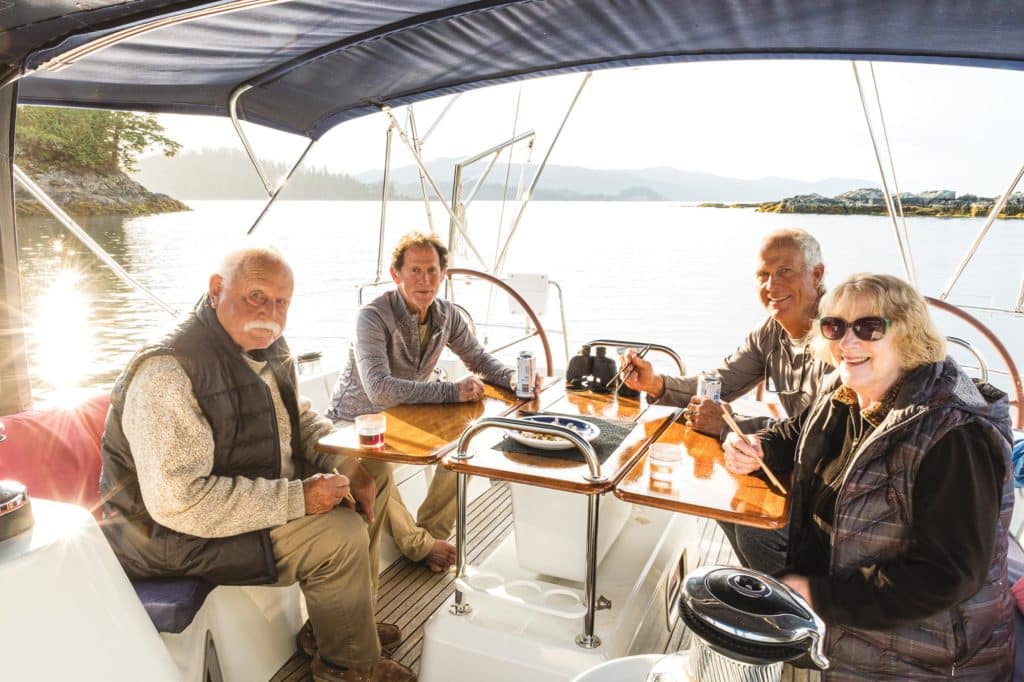
One thing the Pacific Northwest is not famous for is great sailing. Winds are often light and variable, especially in the more-protected areas popular with cruisers. The running joke is that most sailboats here sail with their sail covers on, which actually seems kind of true, or that a sailboat is just a powerboat with funny sticks. It’s really not by chance that the power trawler is the boat of choice for the Northwest. That said, when the wind actually is right, the sailing among rugged peaks covered in evergreens can be utterly magical, somewhat like sailing in an endless mountain lake. We try to get the sails up whenever we can, even if that often means furling them after a few minutes.
British Columbia has such a complex coastline and so many potential anchorages that a good cruising guide is essential. We had the Waggoner Cruising Guide in hand at almost all times, and having Active Captain—Garmin’s crowdsourced, up-to-date electronic guide—on our chart plotter was also a huge help, with many firsthand recent accounts to read. Don Douglass’ several guide books of the area also come recommended.
The anchorages were spectacular, some tucked into the mountains and trees with an inlet only a few feet wider than the boat, with the feel of a serene lake. Others were protected within groups of small islands sheltering them from the open ocean. The Waggoner guide was accurate about one group in particular: the spectacular Bunsby Islands, where we had perfect swimming weather. Waggoner advises that it is essential to stop because other sailors who had done so would inevitably ask if you’d visited, “and you don’t want to disappoint them.”
That said, the British Columbia coast is also a great place to ignore the cruising guides. There are thousands of potential anchorages available, with reasonable depths and good holding. And we found that our Navionics charts were quite accurate but, of course, not infallible. So it’s feasible to find one’s own anchorage, based on the current and expected conditions. My favorite anchorages were those that we chose simply because they looked interesting on the chart, and many turned out to be magical. There is something special about finding your own place, without knowing exactly what you might find there—a little like the first explorers but with a plush yacht.
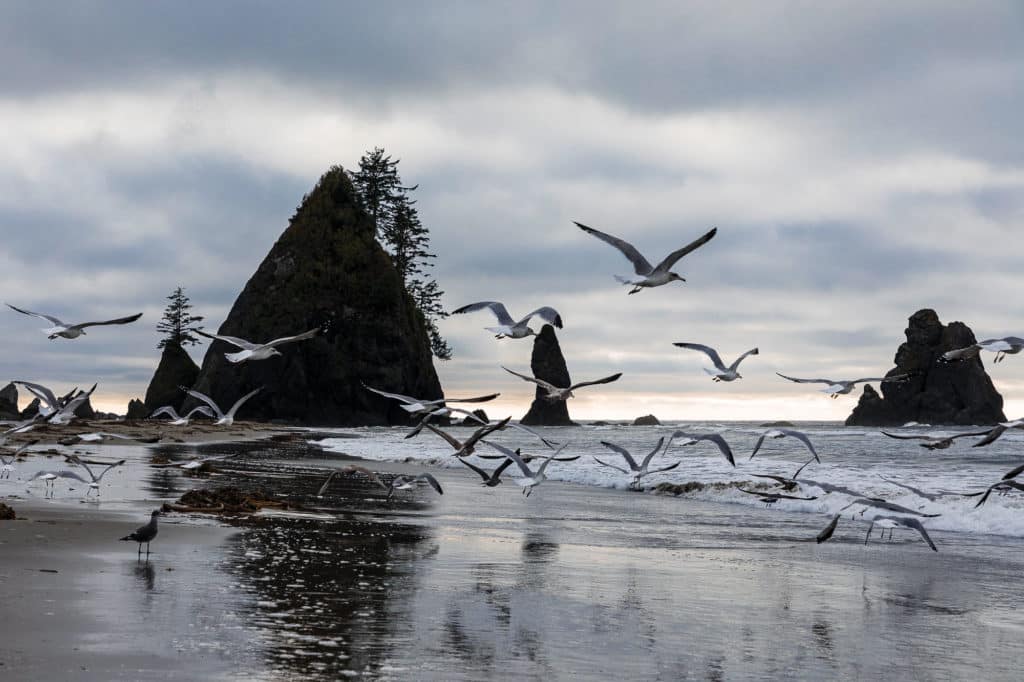
Our descent of Vancouver Island’s west coast was late in the season (September), so most of the fishing lodges had emptied, and the few cruising boats that travel the west coast had mostly moved on. Our first stop on the outside was Guise Bay, on the extreme northwestern tip of the island, just inside notorious Cape Scott. Although untenable in southerly winds, it’s a paradise in northerlies. As proved the rule on the west coast, we found ourselves the only boat anchored off an immense crescent of white sand beach. In fact, we rarely saw another boat.
Yuquot—or Friendly Cove, as Capt. James Cook nicknamed it—was fascinating as a place where First Nations and Europeans have long collided. An old church represents this long struggle, with stained-glass representations of treaties between Spain and England asserting their influence over the area.
At Hot Springs Cove, a half-hour hike along a boardwalk paved with treads carved with the names of visiting yachts from all over the world, brings you to a small and magical hot spring with a hot waterfall you can stand under. It’s essential to catch it before hordes of tourists arrive from Tofino via high-speed boats around 8 a.m., or after they all leave at 6 p.m. Tofino is BC’s surf mecca, and while it is a quaint town with amazing beaches, it’s so full of marinas, high-speed RIBs and seaplane traffic that it feels more like Miami than the secluded west coast of Vancouver Island.
We encountered rough seas a few times on our trip down the outside coast, usually when we put to sea a bit hastily at the tail end of a gale. The thousands of off-lying rocks necessitated careful navigation, even with the excellent digital charts for the area. Being bluewater sailors, we didn’t have a problem with the near-constant Pacific swell, which conversely helps the navigator by marking shallow rocks with plumes of spray.
Keala hosted several generations on this voyage around Vancouver Island—my sister and her family, several sailing friends from around the world and, of course, my dad and artistic Christine, in some of the world’s most pristine cruising grounds. It looks like the years have failed to dull my father’s enthusiasm for cruising. He still feels the same about sitting in the harbor and could barely sit still for a day, even during gale warnings. He prefers to carry on, despite the bears and bad weather.
Tor Johnson is a marine photographer based in Hawaii. You can view more of his work on his website (tjhawaii.com).








